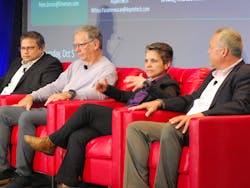Automation intelligence (AI) and machine learning (ML) certainly aren’t new concepts to process control engineers. These technologies have been in play in industrial processes for 30 years or more, but they’ve largely been the realm of the technologist or data scientist. Today, AI has blown the minds of many people, and large language models (LLMs) have exposed generative AI to just about anyone with a Wi-Fi connection and an internet browser. Let’s just say it has more than a few people thinking about the possibilities and the challenges, as well as the dangers of AI.
“We have been working on this for many years and believe it will be a big transformation for all of us,” said Jose Valls, CTO of manufacturing for Microsoft, during a thought-provoking panel discussion called, “Forging Tomorrow: Unleashing AI Benefits” during Emerson Exchange Immerse this week in Anaheim, Calif. “It’s here and it’s not going to stop,” Valls said.
Valls is far from the only one working on generative AI to take notice. “In my tenure, I don’t think I’ve ever seen something that has so much potential,” added fellow panelist Rick Kephart, vice president of technology at Emerson’s Power and Water Solutions business, who has worked in industrial control for more than 30 years. “I’ve become a believer, and I wouldn’t have said that last year.”
AI is winning over many people in the industrial sector, just as it is in a plethora of other industries. At the same time, it stokes fears ranging from the practical—jobs losses, mistakes in production—to the fantastical—a dystopian society run by computers. (Perhaps thanks to decades of Hollywood movies that tend to turn toward the dark side for dramatic effect.)
No need to worry about that just yet, the panelists pointed out. We’re a long way away from a total surrender to autonomous manufacturing and processing plants. Rather, the focus these days remains on the opportunity to use AI to augment human productivity and efficiency. It can also help increase cybersecurity and super-charge real-time diagnostics and predictive maintenance in the plant.
Augmentation or autonomy?
“I’m really interested in the runtime and diagnostics,” Kephart continued, pointing out two areas he’s seen significant benefits already: machinery health and monitoring and reacting to off-normal conditions, much like a digital twin. “I think we are a long way away from taking the human out of [the plant],” he added. “We’ll be needed even if to moderate between competing control functions. I’m a little skeptical about the autonomous plant.”
Rita Wouhaybi, senior AI principal engineer, Intel, also isn’t concerned about losing the human touch at this point. “I love the fact that we’re talking about AI assisting humans,” she said. “Playing the role of assistant is the right attitude.”
For AI to become humans’ helper, it must speak the language of humans, she added. That’s where LLMs entered the party and turned it into a big bash. “It has to be present where anyone can consume it,” Wouhaybi continued. “At the end of the day, is it deployed in my pocket on my phone? Where is the value being delivered?”
Like Kephart, she sees value in diagnostics right now. She added that predictive opportunities are exciting for the near future, saying LLMs are good at predicting the next move. “They are basically saying what the human would do next,” she said.
Nithiya Parmeswaran, vice president of product management at AspenTech, also said the value of AI must be established for industrial processes before companies jump in the water with both feet. “In the industrial space, we need to talk more about the value and less about the technology,” he said. “We need to explain to the end user so they can understand the cost and why they should be using it.”
While the promise is off the charts, the hindrances are still many, with data at the top of the list. The dirty truth about AI is that it can only be as good as the data it is trained on.
The panelist said LLMs must be trained on specific plants, much like digital twins, to be successful. The idea is for the AI to know the plant just as a human worker would, so that it can function as a “shirt tug” to prod humans to react. There’s no doubt the holy grail would be for AI to handle issues itself, but we’re not there yet, they agreed.
Another hindrance, they said, is that AI will have to auto-learn to hit such heights. At the moment, it is reliant upon data scientists to have clean data, but as anyone working with data knows, perfect data is non-existent, so until AI can learn to sort good data from the bad, humans will remain in charge of the plant.
At the end of the day, AI is ready to be a super-worker, but don’t expect it to be the boss anytime soon.
About the Author

Leaders relevant to this article:

